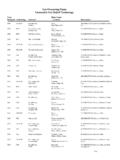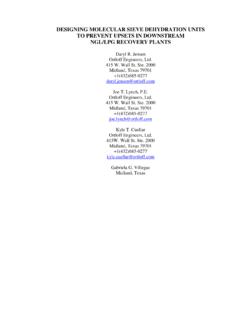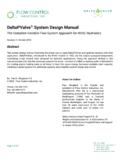Transcription of Dry-out Design Considerations and Practices for Cryogenic ...
1 Dry-out Design Considerations and Practices for Cryogenic Gas Plants Presented at the 93rd Annual Convention of the Gas Processors Association April 14, 2014 Dallas, Texas Joe T. Lynch, , David A. Jelf, J A. Anguiano, Scott A. Miller, Ortloff Engineers, Ltd. Midland, Texas, USA Dry-out Design Considerations and Practices for Cryogenic Gas Plants Joe T. Lynch, , David A. Jelf, J A. Anguiano, Scott A. Miller, Ortloff Engineers, Ltd. Midland, Texas, USA ABSTRACT Time is often lost during startup of new Cryogenic gas plants due to inadequate planning and execution of Dry-out . Lost time can be minimized or avoided if Dry-out provisions are included in the original Design and if good Practices are followed during the Dry-out period. This paper presents the following: Background explaining why Cryogenic plant dry-outs are important to a successful plant start-up The negative effects of water in a Cryogenic plant Dry-out options Recommended Design features for closed-loop Dry-out Guidelines to execute and monitor a successful closed-loop Dry-out The objective of this paper is to explain the importance of drying out a Cryogenic plant prior to startup.
2 It will also explain the advantages of closed-loop Dry-out , which in our experience, can significantly reduce the time required to thoroughly dry the cold plant prior to cool-down compared to the other options. These guidelines and Dry-out Practices are applicable to any turbo-expander Cryogenic plant process Design . -3- INTRODUCTION A Cryogenic plant Dry-out is a critical step during startup but it often does not receive proper attention early on in the project that would allow successful execution. For the purposes of this paper, cold plant refers to a Cryogenic turbo-expander plant for natural gas liquids recovery which recovers liquids comprised of either ethane and heavier components (often referred to as C2+ liquids or Natural Gas Liquids) or propane and heavier components (often referred to as C3+ liquids or Liquefied Petroleum Gas).
3 A cold plant Dry-out can be executed correctly the first time and the owner/operator can be confident the cold plant is dry prior to cooling down when proper Design features are implemented and guidelines are followed. All gas processors know that water must be removed from the cold plant. However, knowing the best method for removing water, how much water has been removed during the course of the Dry-out period, and when Dry-out is complete can be challenging. Far too often a Dry-out is stopped before the cold plant is completely dry. BACKGROUND The solid that forms when water is present with a hydrocarbon stream is not ice , but a crystalline structure known as a hydrate. Hydrates can form at conditions where solids would not be expected, and will form above the freezing point of water.
4 They are a physical combination of water and other chemical constituents, like those found in natural gas processing, which have an ice-like appearance (1). Hydrates form when enough water is present at the right combination of temperature and pressure and tend to favor systems with low temperature and high pressure (2). For the gas plant owner/operator, this means when the plant begins to cool down, hydrates will begin to form in the process areas where sufficient water is present which will restrict or completely obstruct the process flow. It is not uncommon to see hydrates obstructing flow through heat exchanger passes or the strainers that protect the heat exchanger from construction dirt and debris.
5 Hydrates can cause enough pressure drop to rip apart strainers, allowing dirt and debris to enter and damage the downstream heat exchanger. In the case of thermosyphon reboilers and side heaters, hydrate formation may restrict the flow through the exchanger and reduce the amount of heat input to the column enough to prevent achieving the bottoms liquid product purity specification. Hydrates may also form on the cold plant fractionation column trays and packing. The result is a decrease in efficiency causing low product recovery and potentially off-specification liquid product. Hydrates are also known to plug control valves and plant instrumentation. Water can enter the plant equipment through rain or condensation from open piping during construction and through water left after hydrostatic testing.
6 The single most important step that can be taken prior to startup of a cold process plant is to drain and blow out as much free water as possible from the piping and equipment. Eventually, all the water must be removed from the cold plant to the parts per million (ppm) level in order for the cold plant to operate safely and efficiently. Not all of the water can be removed simply by draining low-points. The remaining water must be removed by a combination of moving the water to a low point where it can be drained and absorbing the water in a vapor stream so it can be removed from the cold plant equipment and piping. Several options for eliminating this remaining water are presented in the next section. -4- Dry-out OPTIONS The following options are common approaches to drying out a cold plant prior to cool-down.
7 A description of each option is given, discussing its advantages and disadvantages, in order from the least cost-effective to the most cost-effective option. Option 1 - Pressure Cycling with Nitrogen In this approach, sections of the cold plant are isolated to be pressurized and de-pressurized multiple times using nitrogen. This method requires no piping Design Considerations other than properly locating low point drains and ensuring the drains are of sufficient number and size to remove water from the system. This Dry-out approach requires a large quantity of nitrogen be available and can be very expensive because of the amount of nitrogen consumed. This Dry-out option is less likely to be successful if large quantities of free water ( , puddles of water) are still present in the system.
8 It is more difficult to determine the amount of water remaining in the cold plant after nitrogen purging and determining if all water has been removed from the system compared to the other Dry-out approaches. Water content readings must be taken at many more locations to get an accurate assessment of the amount of water remaining in the system. Option 2 - Once-Through Dry-out Another approach is to flow warm, dehydrated inlet gas through the cold plant equipment and then to the flare stack, re-injection, or a sales gas pipeline. The Dry-out path is operated at as low a pressure as possible. The pressure drop through the cold plant is minimized to prevent any Joule-Thomson (J-T) expansion that would cool down the process while drying the plant.
9 The flow rate should be maintained to move any free water to the low point drains, or to absorb the water in the vapor stream and remove it from the process. A pressure reducing device (such as a temporary flow orifice or valve) must be included to take the pressure drop upstream of the cold section of the plant. Figure 1 illustrates the main process flow path for this Dry-out method. Figure 1 Once-through Dry-out -5- Keep in mind, the Dry-out flow rate may be limited by the flare system s tolerance for flaring or re-injection system capacity. If the wet gas is sent to a sales gas pipeline, monitor the gas water content to ensure it remains below the maximum amount specified. The once through Dry-out is an effective approach, and has been used on many projects; however the Dry-out flow rate can be limited by the flare system or re-injection capacity.
10 For this scenario, the Dry-out period will most likely be longer in order to remove all the water in the cold plant. Option 3 - Closed-Loop Re-circulation In this approach, warm dehydrated gas is re-circulated in a closed-loop through the cold plant back to the dehydration system inlet using a residue gas compressor. The Dry-out loop is operated at as low a pressure as possible without shutting down the residue compressor. The pressure drop is minimized through the cold plant to prevent any J-T expansion that would cool down the process while drying the plant. Again, the goal is to minimize pressure drop through the cold plant but still maintain a high enough flow rate to sweep free water to low point drains or carry the water away in the gas to be removed by the front-end dehydrators.















